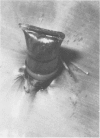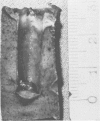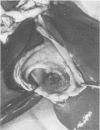Abstract
Cases of traumatic hemobilia are often characterized by a protracted history with recurrent episodes of hemorrhage over many years. It seems that while the liver regenerates quickly and profusely it heals slowly and poorly. This is in contradistinction to the kidneys where lesions often heal within a short time. In order to investigate the cause of this peculiar behavior a series of experiments was performed where local lesions were produced in the musculature, in the kidneys and in the liver of dogs. The healing process was studied at different intervals. There was essentially no difference between the rate and character of healing in the three localities. As the lesions that produce hemobilia are open to the biliary tract, another series of experiments was performed where the healing took place in presence of bile. The effect of this was striking with a very diminished production of fibrinous exudate, granulating tissue and fibrous scar.
Full text
PDF




Images in this article
Selected References
These references are in PubMed. This may not be the complete list of references from this article.
- HARKNESS R. D. Regeneration of liver. Br Med Bull. 1957 May;13(2):87–93. doi: 10.1093/oxfordjournals.bmb.a069601. [DOI] [PubMed] [Google Scholar]
- HINMAN F., Jr, OPPENHEIMER R. Ureteral regeneration. VI. Delayed urinary flow in the healing of unsplinted ureteral defects. J Urol. 1957 Aug;78(2):138–144. doi: 10.1016/S0022-5347(17)66411-5. [DOI] [PubMed] [Google Scholar]
- Hays D. M. Surgical research aspects of hepatic regeneration. Surg Gynecol Obstet. 1974 Oct;139(4):609–619. [PubMed] [Google Scholar]









